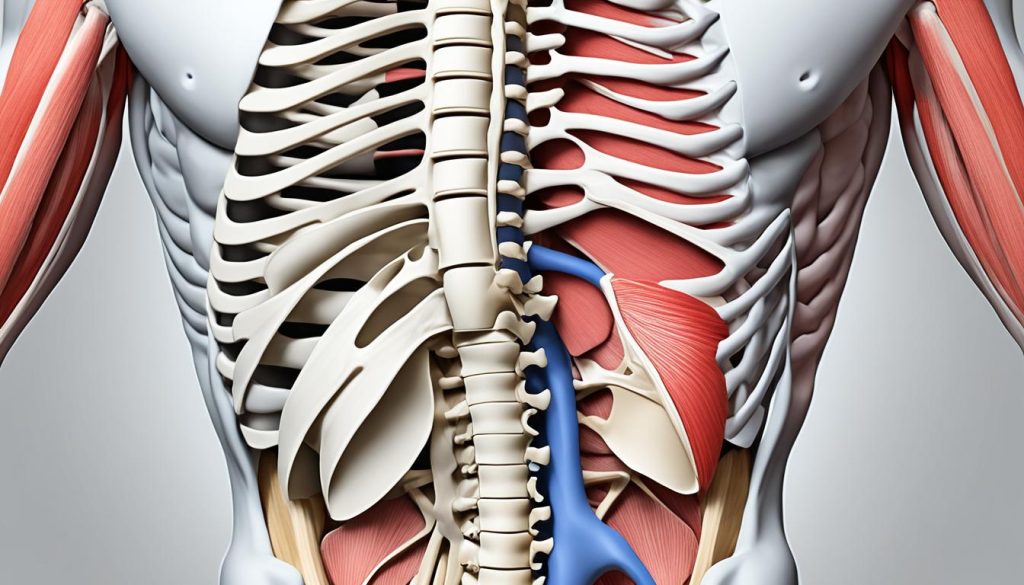Poland syndrome is a rare birth defect, focusing on chest wall deformity and unexpected unevenness in women. It mainly impacts men, but females with Poland syndrome face their own unique hurdles. These challenges stress the need for both the medical world and everyday people to learn more about its effects on women.
In women, Poland syndrome shows up in special ways. This highlights the necessity for customised diagnosis and care. It’s vital to consider both the mental and physical effects of living with such unevenness in women.
Key Takeaways
- Poland syndrome is a distinct congenital anomaly with implications for women’s health.
- Chest wall deformity in Poland syndrome leads to physical asymmetry in women.
- Understanding this condition is vital for providing comprehensive care for affected females.
- Raising awareness about rare conditions in females enhances medical and social support.
- Recognising the uniqueness of Poland syndrome in women is key to patient-centred treatments.
What is Poland Syndrome?
Poland syndrome is known for its muscle deficiency and rib anomalies. It leads to a range of physical issues. Doctors pay close attention not only because of its effects on chest structure but also because of its impact on mental health and dexterity issues. To diagnose it, they look at missing or underdeveloped chest muscles and possible limb problems, which might need chest wall reconstruction.

Spotting Poland syndrome, especially in women, requires looking closely at the symptoms. They can vary a lot. Women face unique issues because of societal views on breast size and self-image. The severity of this condition can be minor, seeming like a beauty problem, or serious, requiring complex Nuss and Ravitch procedures for the chest issues.
Understanding Poland syndrome’s cause is crucial. It’s pretty rare, affecting about 1 in 20,000 babies, but we don’t know exactly why it happens. Experts think it’s due to both genes and environment factors. The trouble starts when blood flow is disrupted during early development, leading to the syndrome’s symptoms.
“Understanding the complex nature of Poland syndrome is paramount for devising effective management strategies. It is not merely a cosmetic concern but can significantly affect the quality of life, demanding multifaceted medical attention.”
Treatment mainly involves surgery to fix the cosmetic and functional issues. Chest wall reconstruction is key for restoring normal look and function. Over time, surgical methods have gotten better, helping patients more. Whether a doctor chooses the Nuss or Ravitch technique depends on the patient’s specific needs and the severity of their condition.
Doctors aim for treatment plans that are specially tailored for each person. They think about the physical, social, and mental effects of living with Poland syndrome. It’s particularly important to treat women with care and understanding, acknowledging their distinct experiences.
Identifying Poland Syndrome in Females
Poland Syndrome affects females in unique ways. It comes with both visible body changes and deep psychological effects. Understanding it fully means looking at how it shows up in the body, how doctors can confirm it, and how it makes patients feel and interact with others.
Physical Characteristics and Symptoms
A major sign of Poland Syndrome in females is when one breast is larger than the other. Doctors might also notice less muscle on one side of the chest or a back that curves in a way it shouldn’t, known as Sprengel’s deformity. There might be skin issues too, like bands under the skin, that show the syndrome is there. These signs vary in how severe they are, but each one affects the body in its own way.
Diagnostic Procedures
Finding out if someone has Poland Syndrome involves several steps. MRI and CT scans are key for looking closely at the body’s structures. These scans show details in the chest area that might not be easy to see otherwise. Talking with a genetic counsellor is also really important. They help figure out if the syndrome might run in the family. Then, a team of medical experts works together to confirm if it’s Poland Syndrome, using all their different skills.
Psychological Impact and Social Awareness
Living with Poland Syndrome means dealing with both physical issues and worries about how one looks. Women might need help from mental health professionals to deal with how others see them. Groups that support people with this syndrome play a big role. They help by boosting confidence and pushing for a world that accepts everyone as they are.
| Specialist | Role in Diagnosis | Relevant Techniques or Contributions |
|---|---|---|
| Radiologist | Execution and interpretation of MRI and CT scans | Identification of thoracic abnormalities |
| Plastic Surgeon | Clinical assessment of physical symmetry | Evaluation of breast asymmetry and muscle deficiency |
| Genetic Counsellor | Assessment of genetic factors | Family history analysis and risk assessment |
| Psychologist | Evaluation of mental health | Assistance with body image concerns and societal perception challenges |
| Patient Advocate | Support and education | Empowerment and facilitation of community resources |
Every specialist plays a vital role in understanding Poland Syndrome in females. Working together, they provide a clear picture of the condition. This teamwork is crucial for making the right treatment plan. It also shows the importance of a strong support network in handling this complex condition.
Poland Syndrome Female: Specific Challenges and Management
Women with Poland syndrome face unique challenges. Bespoke management plans are essential to keep satisfaction levels high. This includes surgical innovation and compassionate care after surgery.
Surgical Treatments and their Efficacy for Women
Cosmetic reconstruction leads the way in treating Poland syndrome in women. Procedures like breast implants and latissimus dorsi flap surgery do more than improve looks. They boost body image and confidence in affected women.
The success of these surgeries is closely watched. This ensures they meet the expectations of the patient and improve their life quality. Here’s a look at how satisfied patients are after surgery:
| Treatment Option | Post-operative Satisfaction | Notes on Reconstructive Outcome |
|---|---|---|
| Breast Implants | High | Symmetry and volume corrected |
| Latissimus Dorsi Flap | Very High | Added benefit of autologous tissue use |
Non-Surgical Approaches
If surgery isn’t an option, non-surgical methods are key. Physiotherapy, custom prostheses, occupational therapy, and lifestyle changes help a lot. They give people with Poland syndrome more independence and a better quality of life.
Treating Poland syndrome often includes physiotherapy and custom-made prostheses. Occupational therapy helps women learn skills tailored to their needs. This enables them to lead fulfilling lives despite their condition.
Support Networks and Advocacy for Affected Women
Those with Poland syndrome often find strength in support networks. This includes psychological counselling and online groups. They offer a chance to discuss the condition in a comforting setting.
Holistic care now stresses health education and body positivity campaigns. These efforts educate the public and celebrate beauty in all its forms. It helps create a more accepting society.
With a blend of medical wisdom and psychological support, managing Poland syndrome in females has evolved. It not only focuses on the individual but also on fostering a society that values all kinds of beauty.
Conclusion
In summing up our discussion, we see that our main aim is to provide comprehensive care for women with Poland syndrome. This care should look after both their body and mind. Treating such a unique condition means understanding the patient’s full situation.
Advancing research is key to learning more about Poland syndrome. By exploring more, we make new discoveries that help us treat it better. This leads to better care and outcomes for patients.
Supporting patients’ strength and resilience is crucial. It’s about patients and healthcare workers building a strong community together. Using patient-centred approaches means every plan is made with the patient’s best interests in mind. Our goal is for every woman with Poland syndrome to feel supported and cared for, always.
FAQ
What is female Poland Syndrome and how does it present in women?
Female Poland Syndrome is a rare condition that affects one side of the chest, often leading to chest and breast asymmetry. It may cause the chest muscle and breast tissue to be underdeveloped or absent on one side. This can deeply affect a woman’s health and how she sees herself.
What are the clinical features of Poland syndrome in women as compared to men?
In women, Poland syndrome mainly causes the breasts to be uneven because one side didn’t develop properly. This issue is more noticeable than in men and affects women differently, both mentally and socially.
Can Poland syndrome be associated with muscle deficiencies and rib anomalies?
Yes, Poland syndrome can result in the lack of major chest muscles and share issues with ribs, like missing or undeveloped ribs. This leads to a noticeable difference in the chest and can affect how the upper body works.
What surgical procedures might be relevant for managing Poland syndrome in females?
For women with Poland syndrome, surgery can help. Options include breast implants or using muscle from the back to correct the chest shape. The best choice depends on the patient’s individual case and what they prefer.
Are there non-surgical management options for Poland syndrome in females?
Yes, there are non-surgical ways to help, like physical therapy, occupational therapy, and special prostheses. These choices aim to improve life quality and support mental wellbeing by addressing appearance concerns.
What role do psychological counselling and social advocacy play in supporting women with Poland syndrome?
Mental health support is key for tackling the effects of Poland syndrome on body image and self-esteem. Community support and awareness also help by fostering a positive environment that encourages resilience and acceptance.
How are imaging techniques used in the diagnosis of Poland syndrome?
MRI and CT scans are vital for diagnosing Poland syndrome as they reveal details about chest and limb differences. This information is critical for planning treatment and management strategies.
Can genetic counselling be beneficial for individuals with Poland syndrome?
Genetic counselling is helpful for those with Poland syndrome and their families. It aids in understanding the condition, evaluating genetic aspects, and discussing the risk for children. It’s a key part of comprehensive care for Poland syndrome.



